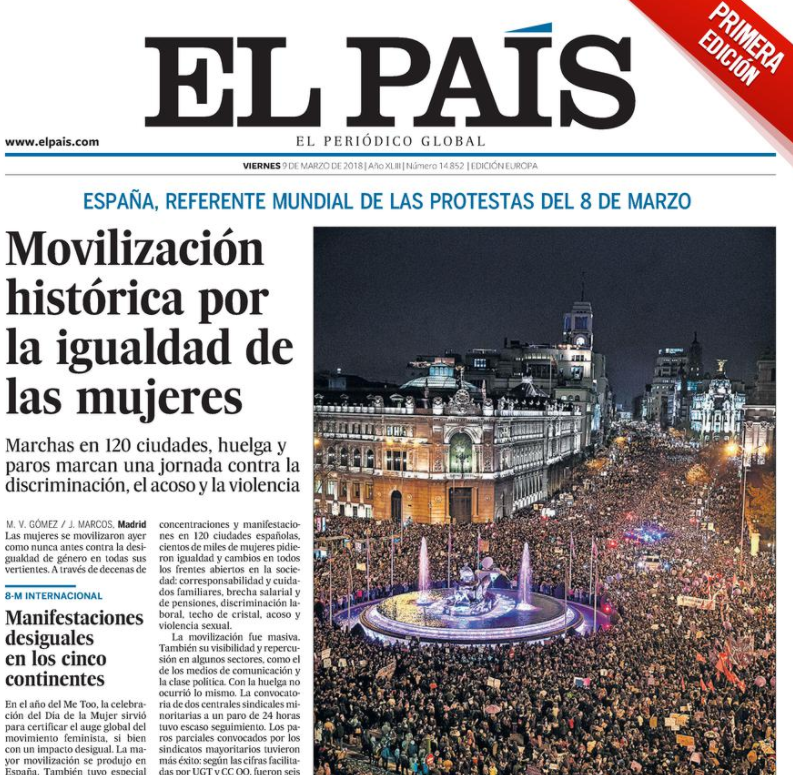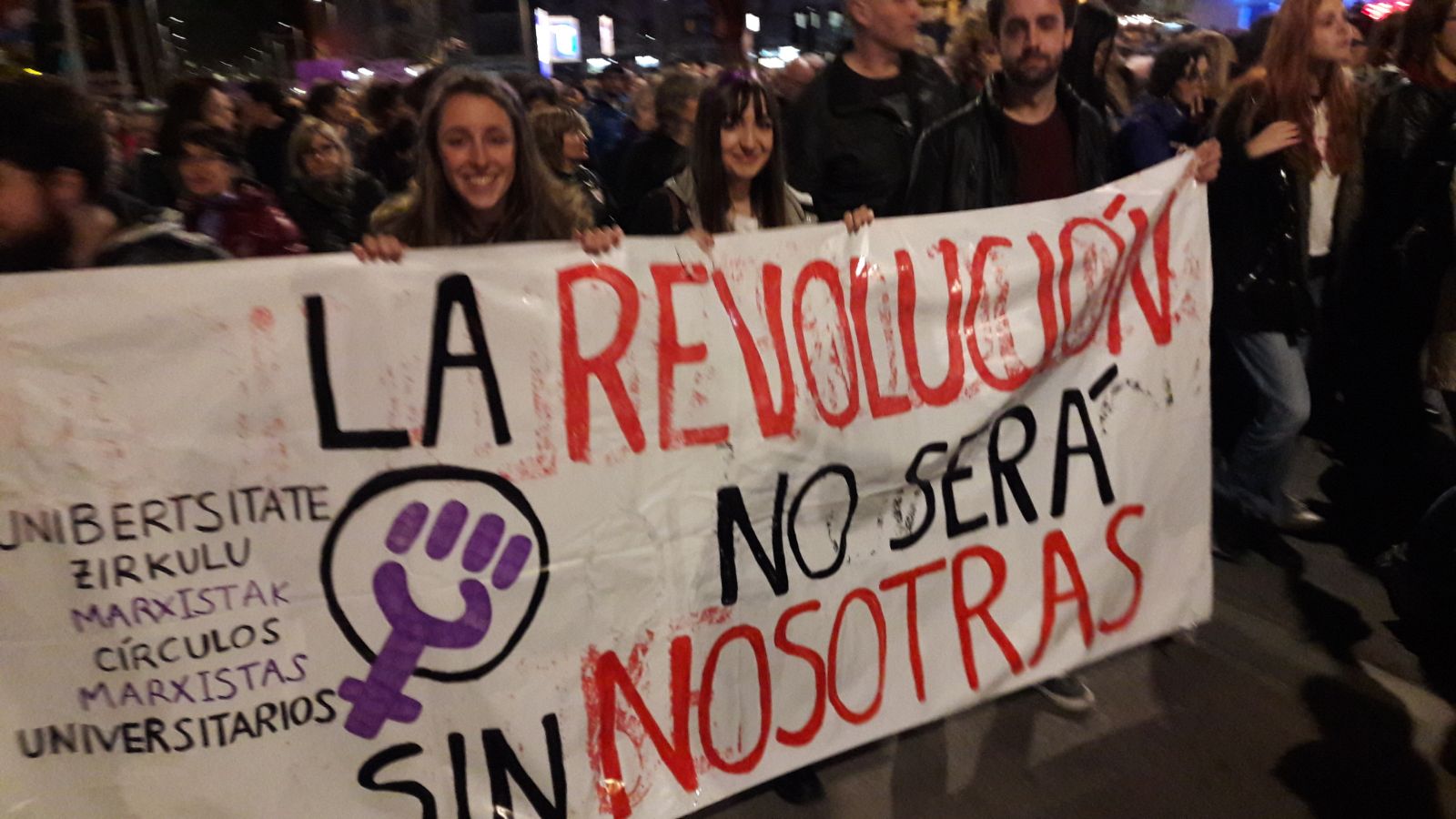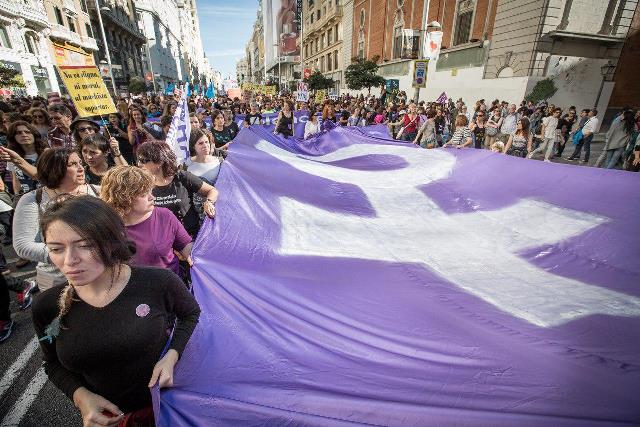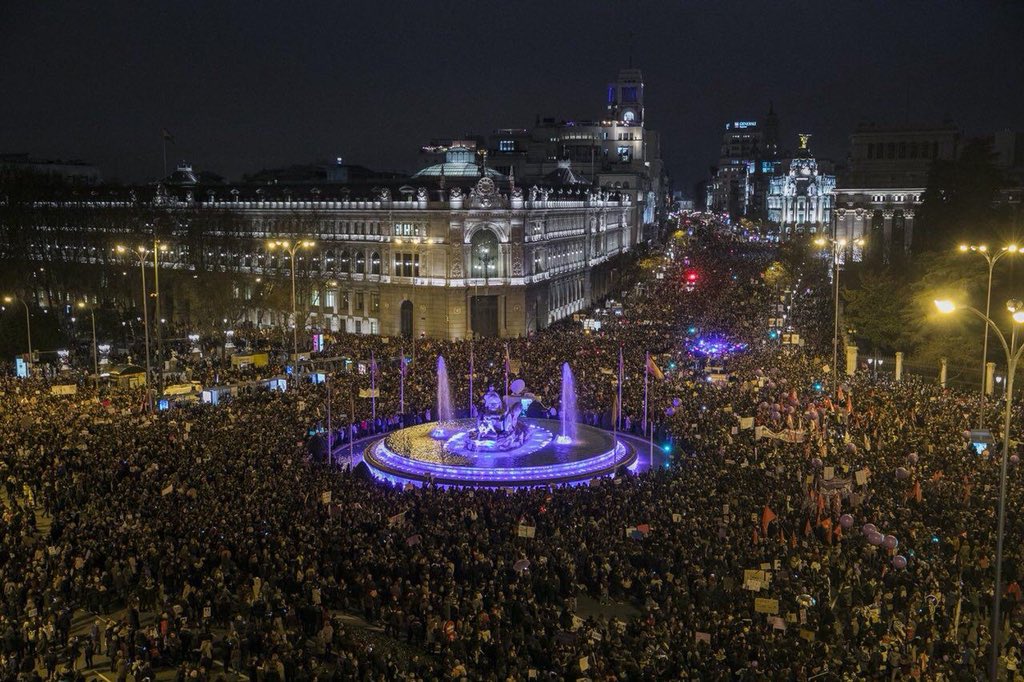What happened in Spain on International Working Women’s Day was remarkable. A commentator in the Barcelona daily El Periódico described it as “more than a strike, almost a revolution”. Over 6 million workers, mainly women but also men, came out on strike, the first time a strike had ever been called to mark 8 March. Hundreds-of-thousands participated in huge demonstrations in over 120 cities in a mass movement that can only be compared to the indignados in 2011 or the huge anti-war marches of 2003.
The women's movement, organised by the Feminist Coordination, had agreed to call for a 24-hour strike, affecting work, study and house work. A number of smaller unions (CGT, CNT, Intersindical, and so on) decided to offer their support and called for a one-day general strike, thereby giving legal strike cover to anyone who wanted to come out. The main unions, CCOO and UGT, limited themselves, under pressure, to a call for a two-hour stoppage in every shift. The trade union bureaucrats gave all the usual excuses: “there is no mood for it, let’s start with something modest”. Of course, with an attitude like that it is difficult to generate a mood for any kind of action!
#Iruña #Pamplona #Impresionante #8deMarzoHuelgaFeminista #manifestacion8M @NavarraTV @AhotsaInfo @Pamplonaactual @ETB@feminicidio @cielikolindo
— Isa Eguiguren (@ieguiguren) March 8, 2018
Intentando hacer hueco para que comience la mani. pic.twitter.com/tYVthRT5TK
Pza del Castillo square
The demands were wide-ranging: from opposing the gender pay gap, to rejecting violence against women, to highlighting the role women play in housework. The call very quickly acquired a political character, which was reinforced by statements from the right-wing ruling party and also Ciudadanos to the effect that while they “of course, support women's rights”, they were against the strike as it had an "anti-capitalist" character! The bishop of San Sebastian added that the devil was behind the call for strike!
On the eve of 8 March there were already sizeable night time demonstrations in Barcelona, Madrid and other cities. The aim was to “reclaim the night”, to demand that women should be free from intimidation, harassment and violence and should be able to walk at any time of the day or night without having to fear for their safety:
"Sense les dones no hi ha revolució" així començava ahir a la nit la #VagaFeminista8M a Barcelona pic.twitter.com/zYkUO5zQjA
— Revolució (@RevolucioCMI) March 8, 2018
8 March started with tens-of-thousands participating in pickets across the country. Some of these were at universities, others at large workplaces, others still were mobile pickets in the city centres shutting down shops, shopping malls, restaurants and fast food outlets. There was confusion over the exact nature of the strike, as the largest unions were only calling for a two-hour stoppage and in many places the union bureaucracy deliberately spread misinformation. Other workers feared reprisals from their employers if they went out on strike and the presence of a large and lively picket outside provided welcome encouragement.
In Catalonia, there were also numerous instances of massive road blockades, following on from the tradition established by the Catalan republican movement in the Autumn.
The strike movement was huge, with millions of workers (women and men) taking part either for the whole day or as part of the two-hour stoppage. In many large workplaces the union bureaucracy from UGT and CCOO did not even properly organise the limited strike they had called for. To give just two examples, at the Renault plants, they had agreed with management a five-minute stoppage, which in fact was just an extension of the morning break. At the big SEAT plant in Catalonia the stoppage was only one hour. There were however other industries and many workplaces in the public sector (in the mass media, education, health care and such) where many workers, individually or in an organised way, decided to take action for the whole day. In total, according to CCOO and UGT, 6m workers took strike action of one kind or another. That would be just under one in every three workers: a huge success.
#M8Planto Jendetza izugarria Bilboko manifestazioan #GrebaFeminista pic.twitter.com/xbhyXGVnEv
— Hamaika Telebista (@HamaikaTb) March 8, 2018
50,000 marched in Bilbao
The pressure of public opinion generated by the movement was so big that even prominent women TV anchors who had berated the strike and opposed it publicly in the days prior to 8 March, were then forced to join the strike, or in same cases were forced off air by strike action in their production teams.
There were also big demonstrations at lunch time in all major cities, with tens-of-thousands participating. The student youth played an important role. In the big cities there were instances in which there were perhaps two, three of even four separate gathering points. The massive character of the movement also gave it a spontaneous feel.
In the evening, massive demonstrations took place across the country in hundreds of cities and towns, big and small. A common characteristic of was that so many people turned up that the whole route of the demo was packed with protesters before the official start, and it took a long time for the queue to reach the end point. In Barcelona, columns from the different neighbourhoods converged into a central demonstration which filled the length of Gran Via and Pl Catalunya:
La capçalera de la manifestació feminista de Barcelona arriba a Plaça Catalunya. Tot Passeig de Gràcia ple de gent. #VagaFeminista#VagaFeminista8M#8deMarzoHuelgaFeminista#WomensDay pic.twitter.com/a9QT5f7SEd
— Nit (@Nitsuga000) March 8, 2018
The organisers put the number at 600,000. The demonstration in Madrid also filled the whole length of the route before it had even started and it took four hours for the whole crowd to reach the end, with the organisers putting the total number in attendance at one million as can been seen on the front cover of El País:
 Image: fair use
Image: fair use
Huge crowds also marched in Bilbao (50,000); in Pamplona-Iruña, where they packed the main Pza del Castillo square; and in Vitoria-Gasteiz the local police put the figure at 70,000 (against a population of 250,000). In Galicia, where there were huge marches in Vigo, Coruña, Santiago and others. In Andalucia there were big demonstrations in Seville, where the local council said 100,000 marched, but the real figure could be two or three times that. In Granada, perhaps as many as 50,000 demonstrated and there were manifestations in Malaga, Cadiz and many more. In Valencia there were also massive demonstrations in the capital and many other cities. Asturias, Aragón, Castilla, the Canary Islands and the Balearic, the whole country was involved in this unprecedented movement.
 According to the police, 70,000 marched in Vitoria Gasteiz, against a population of 250,000 / Image: own work
According to the police, 70,000 marched in Vitoria Gasteiz, against a population of 250,000 / Image: own work
A separate mention must be made of Murcia, where there has been a movement demanding that the high speed train line that crosses the city should be buried. For months there have been daily demonstrations, which have been met with brutal police repression. Today was no exception. There were also instances of police repression in Barcelona and Burgos, but the day passed relatively peacefully, precisely because of its massive character.
ESTÁ PASANDO | Las viguesas lo han vuelto a conseguir. Mira qué Impresionante manifestaciónorganizaron las mujeres de Vigo para reclamar igualdad y libertad. Miles de personas colapsan las principales calles comerciales de la ciudad.
— La Voz de Vigo (@vozvigo) March 8, 2018
(Vídeo: Óscar Vázquez) pic.twitter.com/5k1sfkn6P6
A huge march in Vigo, Galicia
The main focus of the day was of course the demands of the feminist movement. Not only the most obvious issues of violence against women and the wage gap, but also a deep rooted rejection of all instances of everyday discrimination and sexism against women, at work, in public life, at home and in the media. The accumulated anger at a-thousand-and-one seemingly small injuries and affronts exploded into a massive protest for dignity.
The mood everywhere was very militant and dominated by the fighting spirit of young women. One of the most popular slogans of the day was “without women, there’s no revolution”. In fact several people compared the mood of the day to a revolution. In reality a genuine revolutionary movement cannot fail but bring to the front the most oppressed layers, in this case the women. The general mood at these demonstrations can be summed up by footage from the lunch time demonstration in Bilbao (below). A choir sang a traditional workers’ movement song, with lyrics adapted to denounce the oppression of migrant women, precarious women workers and the like. It ends with a chorus of "to the strike, one hundred, to the strike, one thousand... against the male chauvinist state: general strike!!" This demonstrates the movement for women’s emancipation firmly adopting a class point of view and the methods of the working class struggle:
la #HuelgaFeminista8M en Bilbo reivindicando la mujer inmigrante, precaria, trabajadora del hogar, discriminada en la enseñanza ?"contra el estado machista, a la huelga general"! Gora Borroka Feminista #WomensDay ✊ pic.twitter.com/SzaOGg7VPH
— Jorge Martin (@marxistJorge) March 8, 2018
This extraordinary day of struggle was also part of something bigger. In Spain an accumulation of discontent has built up against the impact of the capitalist crisis, the pervasive role of corruption in political life, the stalemate in official politics and the ever growing assault on democratic rights. This had to find an outlet: a channel of expression. In the last few weeks there has been a spontaneous movement of pensioners, which has gathered thousands in the main cities, in some cases breaking through police lines. Many commented: “the pensioners are the example to follow”. Many more now say, after the success of the 8 March movement, “this is what was required, we were waiting for something like this”.
The superficial mood of reactionary Spanish nationalism that apparently dominated only a few weeks ago, has now gone. Swept aside by the fresh air of the class struggle. It is also important to highlight that this movement, like that of the indignados in 2011, like that of the big anti-cuts and anti-austerity protests of 2012 and like that of the Catalan October, went beyond the limits of the official trade union leaders, who played a secondary role and in many instances became an obstacle.
Espectacular #vídeo: Así está #Granada ahora mismo en la #8MarzoHuelgaFeminista por el #DiaDeLaMujer#InternationalWomensDay pic.twitter.com/psZ07mE251
— ideal_granada (@ideal_granada) March 8, 2018
50,000 marched in Granada
The feminist strike has brought to the surface many issues. One of the debates surrounded the question of whether all women have the same interests, regardless of class. This was quickly settled for the majority, as the upper-class, bourgeois women of right-wing Popular Party and of Ciudadanos spent the weeks prior to the strike denouncing it in the most vicious terms. The main bosses’ organisations issued a joint statement against the strike and even threatened to respond to the pickets with a lock-out. Thus, the class nature of the movement became crystal clear.
There was also a debate about whether men should be also called out to strike or this should be a women-only movement. Some argued that since the main aim of the strike was to make women’s contribution to society visible, having men join in would defeat the purpose, including some official spokespersons for the Coordinadora Feminista.
Some went so far as to argue that the role of men at work should be to cover for women who were striking! Even the leader of United Left, Alberto Garzón, argued along these lines. That was the same as calling on men to scab and was firmly rejected by the CGT and the CNT, the unions calling for a one-day general strike. In the end, of course, the movement was dominated by women and particularly young and women workers, but many male workers also participated and supported the movement.
The question of the role of women in house work was also hotly debated, as the call was also for a strike of house work. The old idea of wages for housework as a step towards the emancipation of woman was revived. The comrades from Lucha de Clases explained their opposition to this demand.
Above all, the question of the link between the struggle for the emancipation of women and the struggle against capitalism came to the forefront. For many participating in the strike and the demonstrations it was clear that what is required is a revolution; and for a revolution to take place, women must play a central role. At the Barcelona demo some commented: “this feels like 1917”!
In fact the most astute sections of the ruling class are already busy trying to distance themselves from outright opposition to the strike and attempting to water down its contents and to blunt its sharper edges. An editorial in El País the day before the strike stressed this point. “The defence of equality between men and women…is not ideological and cannot be instrumentalised”. What they meant to say was that the strike was not and should not be anti-capitalist in character, as the ruling PP had accused it of being.
The feminist strike of 8 March has brought about a fundamental change in the situation in Spain. The mood now is one of confidence and strength. We have sensed the power working people possess when they start to move. It is not by chance that this has been brought about by one of the most oppressed sections in society. The strength of collective action will make women more confident in standing up for their rights against sexual harassment and male chauvinism.
 The feminist strike of 8 March has brought about a fundamental change in the situation in Spain / Image: Lucha de Clases
The feminist strike of 8 March has brought about a fundamental change in the situation in Spain / Image: Lucha de Clases
Many times, a false debate has been waged between the idea that in order to fight sexism in society one has to ‘educate men’; and the idea that only after capitalism is abolished can we change people’s consciousness. Educating people can only have a limited impact as long as the ruling class continues to use their poisonous ideology. However, a strike movement like yesterday’s will have inevitably transformed the consciousness of millions of women and men. The attitude of Marxists is sometimes caricatured as: “nothing can change regarding the position of women in society until we abolish class society”. The truth is that, it is in the process of the struggle for rights and reforms, the consciousness of the working class (men and women) starts to change.
These events will have a knock-on effect on the rest of society. The 8 March strike has become an example to follow for all sectors of the working class and the youth in their struggle against the establishment. The main conclusion is: the only way to break the stalemate is by going back to the streets.
On these basis it would be possible to build a movement, linking up all the different demands, which could bring down not only the hated and rotten PP government, but the whole of the 1978 regime with it. All that is missing is a leadership capable of giving the signal.

